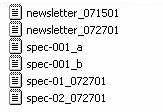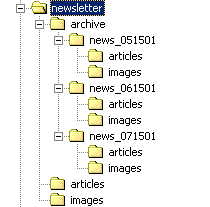
Feature Article: Posted 07/27/01
Content Management - What "Web Authors" and "Web Publishers"
can Do
by George Rogers
The amount of information an individual uses to do their job daily increases 2 to 3 times every year. Most companies are now making the information viewable over the Internet. This is changing the type of audience viewing the information. The audience has changed from a small private controlled audience to a world wide public audience.
Before the Internet
Information generated within your office was viewed by your staff in paper form
and you new who you were distributing it to. You tracked that information by
creating distribution lists and using revision control printed on the document
Now with the Internet
Information generated within your office by one person is viewed by the world
with a web browser over the Internet. Distribution list of viewers of your the
information over the Internet is either to expensive or impossible to create.
Revision control for the information usually does not exist or was an after
thought long after volumes of information had been distributed to a world wide
viewing audience.
Information/Content Management
For this discussion information provided over the Internet will be refered to
as content.
Content management techniques vary between organizations and groups. Most have methods used have the following 3 components: directory structure, data file naming convention, data file revision control. These methods are used to 1) group the file by name and location, 2) date the file by name and location, 3) establish revision by file name and location.
Directory Structure
The purpose of this would be to separate different types of data or different
authors of data by some method. Good directory names and structures will help
you manage the information contained within the directory. Directory names should
be clear and obvious what is contained within them and have purpose. The following
example communicates a company made up of 3 departments. The sales department
has a monthly newsletter starting in january of 2001 and ending in March 2001.
The naufacturing department makes two products: products "a" and "b".
The engineering department has specifications for multiple disciplines including
electrical and piping.

Data File Naming Convention combined with Revision Control
Data file naming convention is also important in helping to maintain content
current. By looking at the file names you can tell what the data file is, date
created, and revision levels. The following example shows us 1) two newsletters
for the dates of 07/15/01 and 07/27/01, 2) one specification named spec-001
with revisions "a" and "b", 3) two specifications; spec-01
and spec-02 written or issued 07/27/01. Any naming convention will work as long
as you know what the data file is by looking at the file name without loading
the file.

Data Directories and Data File Revision Control
The purpose of this would include viewing a current data file and wanting to
review previous versions of the same document. Without revision control you
could not do this. Examples of this would include: newsletters, calendars, standards,
policies, and procedures. Revsion control could be as simple as putting the
last date edited on the data file for user viewing. The following examples include:
1) A newsletter website with sub-directories of archive, images, articles
Note: Notice the whats_new.html file, it lists changes to the newsletter with date and description of change. This could be used for large web sites.


2) Within the newsletter project directory you see an archive directory which includes sub-directories for the months of 05, 06, and 07. These directories include a complete copy of the newsletter before modifications were done for the next month. The directory name describes which month or revision the newsletter is.

